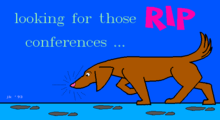I was elated during the BBS days and thought my 1200 baud modem made me da man!
-zridling
Then you also remember an early implementation of online graphics using something called the
Remote Imaging Protocol Scripting Language or RIPscript.
Ah RIP! Those were truly
god-awful graphics, most of them:

Fuchsia and cyan text on a royal blue background? Awesome! No wonder I'm half blind now that I'm older.

RIP might have gone somewhere if the developers (TeleGrafix) could have managed to get their act together and abandon some of their grandiose licensing schemes. (End-users could get software to display RIP graphics for free. BBS owners were expected to pay TeleGrafix a fairly hefty license fee for an editor to create these graphics.)
Since most BBS operations were true labors of love - and most sysops were already broke after paying Ma Bell for multiple analog phone lines to plug their 96oo baud modems into - Telegrafix didn't get too many takers.
But overall interest in displaying images online still remained high. So shortly afterwards, inexpensive shareware and crude freeware RIP editors began appearing.
If this happened today, as opposed to in 1994, Telegrafix would have likely owned a patent and taken everyone to court. But software wasn't generally considered to be patentable back then, so the IP litigation route wasn't a viable option for most companies.
And there was a huge amount of public resistance to the notion of licensing "formats" back in those pre-Internet days. Even the mighty CompuServe had to back down in the face of public outrage when they began hinting they were thinking about assessing license fees for the use of GIF format images. Their announcement enraged so many software developers that it led to very serious threats of their abandoning support for GIF completely. This fracas ultimately led to the development of the PNG image format before CompuServe finally realized the battle was lost and gave up.
Then along came Mosaic and Netscape in 1994 and it was "Game over, man!"
Article on RIP can be found
here if anyone is interested in "yet another road not taken."

